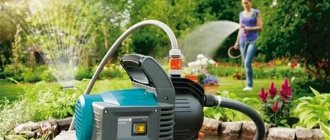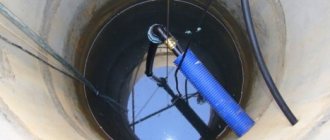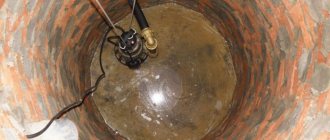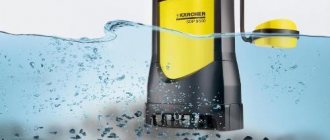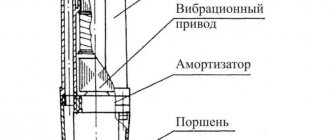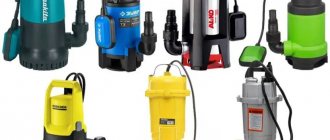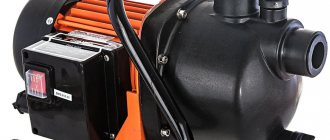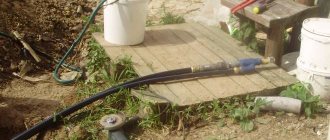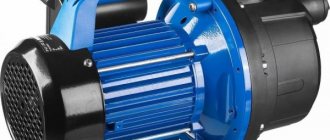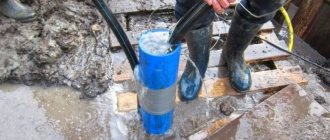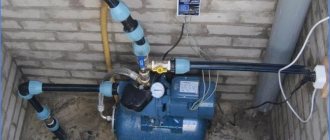Owners of private houses with premises located below ground level purchase pumping equipment for pumping wastewater and groundwater in the event of seasonal or emergency underground flooding. The presence of water in the cellar negatively affects the materials of the foundation, ceilings, subfloor, and contributes to the appearance of mold and dampness on the 1st floor of the building. Unwanted liquid is removed using permanently installed or portable electric pumps.
What is a basement pump?
This is not specifically specialized equipment that serves exactly this purpose. A conventional drainage, sewage or surface pump is optimal for pumping out water. They can be used not only to drain the basement, but also for many other purposes:
- for pumping water out of trenches and pits during construction;
- for draining swimming pools, pumping water from various reservoirs;
- for watering garden and vegetable crops from lakes, barrels, etc.;
- when replacing water in decorative ponds and reservoirs.
Technical features of using different types of pumps for draining basements.
Surface pumps for the basement.
In this case, the pump itself is on the surface, and the supply hose is lowered into the basement, into its deepest place. The problem in this case may arise as follows - blockage of the suction hole with various debris in the water. We recommend making sure that there will be no problems with this or using an additional mesh. In this case, the entire process should be monitored, since not all surface pumps have dry-running protection, and if water stops being sucked in, the equipment may simply fail.
Sewage pumps for the basement.
This option is more preferable, since most models are equipped with a float, and when the water level drops to critical, it automatically turns off. Almost all models have the following feature - the suction hole is reliably protected from large inclusions, this is important if debris, leaves, etc. get into the basement. Some models of fecal pumps are equipped with a chopper blade, which is an additional insurance against blockage. Such equipment is always a problem-free solution.
Drainage pumps for the basement.
As a rule, basements and cellars in Russia are filled with melt water in the spring, or groundwater comes too close. That is, the water level simply rises in this room, without much debris or pollution. In this case, the optimal and most cost-effective solution would be to use a drainage pump. Most of these models are designed for pumping dirty water, with inclusions of a certain diameter, so there should be no problems. Any correct drainage system, like its fecal counterpart, is equipped with a float for automatic shutdown and thermal protection. The choice of a specific model depends on technical tasks and personal preferences.
In most cases, we recommend using a drainage pump for this task, as it is the best option in terms of price and technical requirements.
Features of basement pumps, what determines the price
We recommend paying attention to the following parameters of this equipment (we are talking about fecal or drainage pumps).
- Pressure is measured in meters. This indicator indicates to what height the pump can supply liquid. That is, when purchasing, you should take into account the depth of the basement and the drainage level. Naturally, the price of models with a high pressure indicator is higher.
- Productivity - in cubic meters per hour. The volume that the pump can pump out per hour. Different models have different performance, with larger ones costing more.
- Power - in kW. This is actually the device's power consumption. The higher the pressure and productivity, the more electricity is consumed.
- Case material. There are several options here - plastic housing, cast iron, stainless steel and intermediate models, including, for example, parts made of both plastic and stainless steel. The budget option itself is a plastic case. Stainless steel also has a longer service life, and in the event of accidental impacts, the case will not crack or break.
- Availability of pump protection systems - from overheating, automatic shutdown when the water level drops. All this will allow the equipment to operate for many years without unnecessary problems.
The higher the pressure, productivity and power, the higher the cost of the equipment; additional options in the form of a stainless steel body and protection options also increase the price of the product.
How to deal with basement flooding?
Not only the basement, but the entire area suffers from excess moisture: the foundations of buildings are washed away, poor tree growth and frequent plant diseases are observed, in winter the soil swells and destroys paths.
Therefore, the most effective measure is to remove moisture from the entire area by installing a drainage system.
If for some reason this option seems impractical to the homeowner or too labor-intensive (it involves significant excavation work), you can concentrate your attention only on the basement, installing a waterproof barrier or an automated water removal system in it. Next we will discuss all the mentioned methods.
What is a sump pump used for?
Pumps for pumping out water are necessary in the presence of underground buildings, such as basements, cellars, basements, etc. However, this is far from their only purpose.
The pump is also used in the following cases:
- drainage of trenches and pits during construction work;
- preparing the local area for winter: draining pools, fountains and other reservoirs;
- watering the garden and vegetable garden from open sources: lakes, barrels, streams, etc.;
- replacing water in swimming pools and decorative ponds;
- extinguishing fires.
Submersible sump pump in the basement
These are not all the cases where a sump pump can be used.
This device is an indispensable assistant in any situation when water needs to be pumped out or pumped somewhere.
Causes of flooding and pump selection
There can be several reasons for flooding of a basement or ground floor:
- seasonal flooding of underground buildings during spring floods;
- close occurrence of groundwater;
- burst of water supply or sewerage.
It is the reasons for flooding of basements and basements that are an indicator of which pump to pump water from the basement to choose.
In the case of seasonal flooding, water can be pumped out from the basement once a year after the flood has passed and the water has settled below the level of underground buildings. That is, there is no need for the pumping device to be permanently located in an underground room.
In the case of close groundwater, the drainage system must operate continuously. Consequently, the pump is installed during construction in a special collection tank and is removed from there only for maintenance. In such situations, the drainage pump should work automatically: turn on when the water reaches a certain level and turn off after pumping it out without human intervention.
If the flooding of the basement occurred due to a break in the water supply or sewer system, the situation changes somewhat. In this case, of course, the pump is used once, but other nuances arise here. In case of a break in a cold water supply, any drainage pump will do.
Motorized pump
If hot water pipes rupture, the pump should be selected based on the temperature characteristics of the pumped medium.
If the cellar or basement is flooded with the contents of sewer pipes, a fecal pump will be required. The peculiarity of the fecal unit is that it is capable of pumping liquids interspersed with solid particles of large diameters or even grinding them.
Technological features of pit construction
The easiest and fastest way is to buy a factory-made structure. In this case, you only need to dig a pit of a suitable size with your own hands and ensure water drainage.
The body is made of the following materials:
- Composite (propylene, polyester, fiberglass reinforced). The grille is able to support the weight of the car. They are practical to equip recesses installed at ground level in places where people and equipment can move.
- Cink Steel. When combined with the same grille, it serves as protection against unauthorized entry through pits in dachas and country houses without permanent residence.
Finished products come in various designs for given conditions: vehicular and pedestrian loads, high groundwater (reinforced waterproofing), installation on a thermal insulation coating of the foundation.
The standard kit includes the following items:
- frame;
- covering grid;
- installation kit.
Pits under the windows
The design should be done in stages, taking into account the prospects for changing geological, climatic and operational conditions. Data for the first 2 categories (multi-year cycles and development plan) can be obtained from your local architectural office.
An individual pit design is developed based on the following parameters:
- The width of the pit is selected 1.5 times larger than the same window dimensions.
- The depth of the finished recess after laying the materials and cladding must be at least 0.25 m below the frame in the opening.
- The area of the bottom plane for drainage is commensurate with the surface of the window block. The rectangular shape will save house space on the ground surface. The distance from the wall is within 0.8-1 m.
The main nuance is drainage. If the water is located significantly below the foundation, then the drainage occurs through a perforated pipe into a well at least 1.5 m deep. The moisture will spread into a cushion of crushed stone under the base.
High water in the soil will require connecting pipes to a drainage system or a separate well with removal outside the site. Before installing the floor, the underlying base is waterproofed and insulated. The lower plane is sloping towards the drain.
At the stage of pouring the walls with concrete, formwork is made from boards or plywood. The thickness of the monolith is chosen to be at least 15 cm. To prevent the flow of liquid from precipitation or cleaning the area, or the entry of large debris during strong winds, it is advisable to raise the upper edges of the pits by 0.15-0.2 m above the blind area. Reinforcement is rarely used in this design - you just need to ensure a rigid connection with the wall using anchors (for example, long nails driven in half). A decorative canopy will provide additional protection from rainwater.
Drainage pits
So that water in the basement can be pumped out from one point, drainage recesses are installed towards which the floor slope is directed. The walls are concreted in the shape of a rectangular well with a wall thickness of 0.13-0.15 m.
The operations are carried out step by step according to the following scheme:
- Dig a hole with a volume of 1 cubic meter. m under the pit in the center of the basement. The size is directly proportional to the area of the underground.
- Make another recess in the bottom according to the diameter of a regular bucket. A stainless steel container is inserted into it - this will be the suction pipe of the pump.
- The walls are made of solid red brick (silicate brick is less resistant to water).
- The brick can be protected with 3 cm thick cement mortar or covered with ceramic tiles.
- The top is covered with a grille made of reinforcement, which allows the hose to be lowered without the leg falling through.
In a frequently flooded cellar, pits can serve as an indicator of the rise in ground seasonal moisture. For this purpose, they install with their own hands below the floor level stainless steel (aluminum) tanks with a capacity of about 250 liters with drilled holes in the walls. When water appears, the electric pump with automatic float switches on, and it is pumped out into the storm drain. This approach prevents flooding at an early stage. Over time, the amount of water entering the basement decreases and the pump operates several times less often.
What types of basement pumps are there?
All water pumps are divided into two subtypes:
- Mechanical.
- Electrical.
Mechanical or hand pumps are driven by human physical force. Based on their operating principle, such pumps are called piston pumps. It is the movement of the piston that sucks water into the pump bowl and then pushes it out.
These devices are indispensable in cases where there is no electricity in the area. However, it is worth noting that pumping water with such devices takes a lot of effort and time, so it is impossible to pump out large volumes of liquid and even in a short time.
Electrical devices are much more expensive than mechanical ones and require additional energy costs. However, these units are able to create maximum comfort and fulfill any user requirements without expending physical effort. In addition, almost all electrical units can be combined with various types of automation and switch them to fully automatic mode.
Submersible drainage pump design
Electric pumps have a wide range of installation methods, operating mechanism, manufacturers, types of automation, etc. Let's take a closer look at some of their subtypes, most often used in basements and other underground buildings.
Superficial
A surface water pump is used for one-time pumping of the tank. This is due to design features and technical characteristics. This type of unit, unlike a submersible one, is air-cooled and under no circumstances should it come into direct contact with the pumped liquid. The advantages of surface pumps include:
- low cost due to the simplicity of the design;
- ease of installation and maintenance. This type of pumping device is installed on the surface, making it easy to move, convenient to monitor and no problems with maintenance;
However, the surface pump has many disadvantages:
- maximum liquid lifting height – 9 meters;
- the inability to pump out water completely, because when air is sucked in, the device turns off automatically;
- noise, since the operation of the engine is not muffled by the environment (water, as is the case with submersible devices);
- leakage of the housing, due to which the pump must be protected from moisture and precipitation.
However, such units are almost always chosen if you just need to pump out a tank or water an area, since in these cases the described disadvantages practically do not play a role.
Installing a surface pump is very simple: a hard hose is lowered into the pumped out reservoir, and a soft watering hose is taken to the place where the liquid is drained. The basement pump is ready to go.
Surface drainage pump
At the end of pumping out the liquid, the pump is disconnected from the power supply, after which it can be removed or moved to another tank. These devices are small in size and weight, making installation, dismantling and transportation easy for anyone.
Submersible
Submersible pumps are usually used to install a stationary drainage system for a basement, cellar or basement. They are also very convenient for one-time pumping out of liquid, since they can remove it almost completely. However, few people can afford to buy such a device for one-time use, since they cost much more than surface ones.
The high cost of submersible pumps is due to their design features. Such units use materials that are not subject to corrosion under conditions of constant contact with water. In addition, submersible units must have a completely sealed housing. We also note that almost all submersible pumps are equipped with level automation - special senders that automatically turn on the pump when the liquid level rises to a certain level and turn it off when the liquid settles to a lower level.
Submersible models are capable of lifting liquid from great depths - 100 meters or more. Such deep characteristics are important for borehole and well pumps.
The aquatic environment in which such devices are immersed muffles the engine, making them much quieter than surface models. In addition, it is water that acts as a coolant for the entire mechanism.
According to their purpose, submersible pumps are divided into:
- borehole;
- wells;
- drainage;
- fecal.
We will not consider the first two types, since they are used exclusively for supplying clean water from great depths.
Installation diagram of a drainage pump in the basement
Drainage pumps are capable of pumping out both clean and dirty water with small inclusions of solid impurities. To prevent particles larger than the permissible diameter from entering, the intake part of the drainage device is equipped with a mesh filter with a specific cell.
Sewage pumps, by definition, are used to pump out sewer pits. Their main purpose is to pump liquid with large inclusions of solid impurities. To avoid damage to the mechanism, fecal devices are equipped with a cutting mechanism capable of grinding household waste to a homogeneous mass.
Drainage electric pumps
An electric drainage pump is a device specially designed for pumping water out of a flooded room. The equipment has a narrow specialization. Using the pump for activities not specified in its instructions is highly undesirable. However, many homeowners often set difficult tasks for the device and look for unusual uses for it. There are cases when enterprising owners tried to replace the fecal drainage pump.
The equipment can pump out liquids with light contamination. Solid impurities should not be larger than 3-4 mm; the exact indicators depend on the indicators of the device. At the same time, the fecal electric pump provides for working with aggressive liquid. The design of the drainage pump is represented by the following elements:
- Electric motor.
- An impeller, the location of which is the shaft. It provides the function of passing liquid through the device.
- Pumping unit. It contains an intake pipe. Water enters the pump by passing through holes in the tube.
- Frame. Includes all available working parts of the unit.
- Circuit breaker. Performs the function of switching off and on, which depends on the amount of liquid, and also prevents dry operation and flooding of the drainage hand pump.
To ensure normal operation of the device, the presence of solid components inside the chamber should not exceed 10% of its capacity. In addition, the range of equipment is not used for pumping hot water. There are two types of devices - surface and submersible.
Motor pumps
Motor pumps operate using centrifugal force. Appliances for domestic use are equipped with gasoline engines. An important technical detail: the higher the device is located above the injection point, the less efficiently it will work.
Advantages of motor pumps:
- mobility;
- independence from access to the electrical network;
- efficiency;
- high performance;
- wide range of applications.
Disadvantages of motor pumps:
- limited time of continuous operation;
- Regular inspection, oil and filter changes are required;
- limited depth of water intake;
- work only with clean and slightly contaminated water;
- harmful emissions;
- high noise level;
- impossibility of working near a muddy/sandy bottom;
- inability to work indoors.
Manual
Such equipment is suitable for homes where it is not possible to use sockets or where electricity has not yet been supplied. They pump out small volumes of water. Diving is only possible to 5-9 meters. The principle of operation is similar to a piston, which creates a vacuum of pressure and lifts water upward.
Mechanized
Depending on the energy source, pumps differ in:
- Units with a gasoline engine or running on diesel fuel;
- Electrically powered equipment that uses electricity.
Vibrating electric pumps
They have such advantages as low power consumption and low price. However, when used, they are subject to strong vibration, which harms the mechanism during operation. The design itself is very simple. The components of the device are represented by the following spare parts:
- Electromagnet. Has a core and winding.
- Vibrator. Includes an anchor in which the rod is pressed.
- Frame. It is equipped with a valve that closes the inlet.
To date, the production volume of these units is over 1,000,000 units per year. But at the same time, the demand for vibrating electric pumps for pumping out dirty water is still not satisfied, because the equipment copes well with pumping out liquid in a flooded basement, and if treated with care and attention, it can become your assistant for many years.
There are vibration pumps
To get started, simply place the device on a hard surface and plug it into a power outlet. If you want to purchase this type of equipment, you should familiarize yourself with the characteristics of the mechanism. The main indicator to pay attention to is productivity. Some companies offer up to 1200 liters of pumped water per minute of operation.
Attention! When purchasing equipment, you should take into account the distance of the outlet and select a design with the appropriate cord length.
Screw well or borehole types
A screw well pump is classified as a submersible type of water equipment. When pumping out liquid, the device is lowered into the water and takes it in, generating the pressure required for lifting from the depth. To carry out the process, several schematic models are possible, let’s analyze one of them.
The unit is available from a wide range of manufacturers in a large assortment. There may be some differences in configuration and design, but the general plan for the functioning of the device in such devices is the same.
Schematic overview of the well pump design
- The housing combines all existing elements of the electric pump. The material for its manufacture is metal, since the polymer is not able to withstand the load exerted on a mechanical object.
- The rotor provides pumping of excess moisture. By making rotational movements, it pumps out water, which falls into the hose under pressure.
- The rotor rotates via a rigid shaft. In addition, many different elements are responsible for the workflow. A high-quality device is equipped with a more complex technical device, but at the same time it has a longer service life due to reduced wear of spare parts.
Types of household pumps
The entire variety of pumping equipment can be divided into several types:
- drainage devices;
- fecal pumps.
How do they differ from each other? In terms of operating principles, there are no significant differences between them. And all because the main task for which they are purchased is pumping out liquid.
If we talk about drainage pumps , then depending on their model, these installations can pump small fragments of solid waste along with water. To prevent damage to the mechanical parts of this pumping equipment, a filter made of a mesh with small cells is installed on the lower section of the pipe. Filter products are made of material that is not subject to corrosion. If there is a filter, particles will not get inside the equipment.
A fecal pump for pumping water from a basement differs from a drainage pump in that it does not have such a filter. Its main purpose is related to pumping wastewater and soft inputs like paper. To ensure high efficiency of its operation, depending on the model, it can be equipped with a cutting mechanism, which crushes large particles during operation of the equipment.
According to such a criterion as the method of operation in a liquid medium , both types of pumping equipment are divided into:
- submersible;
- external.
When a submersible pump is used to pump water, it is completely submerged in wastewater. Pumps of the second type are immersed in the aquatic environment with their lower part, and the main one is located outside. Pumping out wastewater and groundwater is carried out by a small part of it, which is lowered into the aquatic environment.
DIY aeration fields
Aeration fields, irrigation fields or even filtration fields are all names that describe a single treatment drainage facility that helps with the discharge of treated wastewater into the ground.
The operating principle of filtration fields for a septic tank is the distribution of purified water over a certain area. Properly constructed aeration fields further purify wastewater, and according to some information, by another 20-40%. This is a very good result, which means that you do not pollute the soil of your own summer cottage with such a system.
Most septic tanks operate according to a fairly simple scheme, but it is optimal and effective only if all internal units and system elements are correctly installed and connected
Constructing filter fields is quite simple. To do this, you need to dig several trenches, depending on the number of branch pipes from the septic tank. Next, fill these trenches with sand and gravel, creating a 20 cm cushion over all of them. Afterwards, install perforated pipes over the trenches, which will produce a distributed discharge of water.
What do filter field experts recommend?
There are many opinions of experts on installing drainage systems, but we have selected the most significant of them:
For aeration fields, plastic perforated pipes are used, at the edge of each of which a ventilation outlet must be installed. To prevent siltation of the perforation, the pipes are wrapped with geotextiles, backfilled with gravel, and special load-bearing platforms are built. The system is installed in an unused place in the dacha so that it does not disturb the plants with an increased amount of water in the area, and the plants do not spoil the system with their roots. The entire system is assembled with obligatory attention to the requirements of the septic tank and water discharge, as well as depending on the characteristics of the soil. By the way, the system is being built on sandy loam, loam and sandstone, always below the freezing level. For laying pipes, the same slope is selected and installed for proper distribution of water. Autonomous sewer systems or local treatment plants, the same VOCs and septic tanks from many manufacturers are an excellent alternative for a summer cottage
Autonomous sewer systems or local treatment facilities, the same VOCs and septic tanks from many manufacturers are an excellent alternative for a summer cottage
Selection rules
The choice of any electrical equipment must be taken seriously. Basement pumps are no exception. Before you go to the store for such a purchase, you need to understand where, for what and how often the pump will be used.
The first characteristic you should pay attention to is performance. It is calculated based on the amount of liquid that needs to be pumped in a certain unit of time.
The second is the depth of the pumped out reservoir.
It is better that the equipment has a 30% power reserve relative to your calculations. This will guarantee its protection from overloads and unexpected breakdowns.
Fecal pump with grinder
When choosing a submersible model, you need to pay special attention to the material and tightness of the housing. Saving on quality can lead to corrosion and failure of the pump in the first months of its operation.
When choosing a pump for permanent drainage, it is better to give preference to automatic devices. This will completely free you from responsibility for its operation and the user’s forgetfulness will no longer cause the unit to break down.
And finally: you shouldn’t skimp on electrical equipment so you don’t have to pay twice. It is better to buy such units in specialized stores and choose trusted brands. In this case, you receive a guarantee and the possibility of service.
Where to start when choosing
Start your choice with the following - measure the height of the rise of water from the basement to the surface. This is an indicator of pressure. Naturally, it is better to choose a model with a small margin for this parameter.
Next, calculate the approximate volume - how many cubic meters of liquid you will need to pump out, and by comparing it with the pump’s performance, it will become clear over what period of time this is possible.
Need to drain your basement quickly?
- take a model with high performance, but it will be more expensive. Do you have time? A low-performance pump with the same pressure rating will be sufficient.
Five main mistakes when choosing a device for pumping water
- Purchase of a surface pump for pumping water from great depths. If the depth of the well is more than nine meters, only a submersible device will cope with the task.
- Attempt to work with chemical liquids. Most household appliances are designed only for pumping water. To operate in aggressive environments, pumps made of special durable materials are used.
- Choosing a weaker pump to save on electricity. A 1000 W pump will do the job in an hour, a 400 W pump in 2.5 hours. Electricity consumption will be the same. It is worth considering the depreciation of the engine: the less time the engine runs, the longer it will last.
- Choosing a more powerful motor pump than required for work. To pump water from a shallow basement and irrigate a small garden, a device with a capacity of up to 20,000 l/h will be sufficient. If you buy a device with a higher power, then a) you will overpay for the machine itself, b) during operation you will pay more for fuel and maintenance.
- Misreading the characteristics. Manufacturers indicate maximum values calculated based on operation at so-called “zero points,” ideal conditions. Example: a motor pump with a power of 400 W, a capacity of 7000 l/s and a lifting height of 6 m. Task: to lift water from a well 3 meters deep and drain it into a tank located at a distance of 30 meters. Bottom line: the pump will not cope with this task due to the losses that will occur when lifting and pumping water.
Installation of ready-made structures
Modern construction companies today offer a fairly wide selection of ready-made structures for arranging pits. By purchasing such a product, you can easily equip pits in the basement: the only thing you will have to work on is digging a pit to fit the dimensions of the purchased structure.
Installation of the finished structure.
Today, ready-made pits are made from different materials. It can be galvanized steel, propylene, plastic or polyester. The latter option, reinforced with fiberglass, has such strength that structures made from it can easily withstand not only the weight of an adult, but even a car. Therefore, such designs are the most popular.
Replacing old elements with new ones.
Metal, in particular steel structures, also have their advantages. Thanks to the galvanized surface, they are not exposed to moisture. In addition, most are equipped with anti-vandal devices. This option is perfect for country houses in which there are no permanent residents. Iron bars for pits will protect not only windows from mechanical damage, but also the home itself from thieves.
Typically, ready-made pits on the market include the following required elements:
- Well body.
- Grills on the windows.
- Set of fastening devices.
The design and manufacture of pits involves certain technological subtleties, but installing ready-made pits is not difficult. Any man (familiar with construction) can cope with this work without the involvement of specialists.
The well body is installed in the finished pit, all communications are connected (drainage, discharge, grate on the drain pipe). After all the above work, all that remains is to install a fence or grate for the pit, and the structure is ready. All structural elements are attached to each other and to the wall with special dowels, which are included in the product package.
The finished pit is also good because it does not need additional insulation. The only drawback of ready-made structures is their price. This pleasure is not cheap. Therefore, if you are not ready to spend a lot of money, you can try constructing a pit yourself.
Safety rules when working with pumps and pumps
Safety requirements when using submersible drainage pumps:
- During operation, do not touch the liquid, cable, or objects that come into contact with water - there is a danger of electric shock;
- After each use, run clean water through the pump or rinse it;
- do not forget to remove the plug from the socket after completing all tasks.
Safety requirements when using motor pumps:
- do not work in a closed, poorly ventilated area;
- Always stop the engine before refueling and allow it to cool;
- do not refuel the motor pump near an open flame, do not smoke during the process;
- Do not allow fuel to come into contact with the engine or muffler during refueling;
- install the motor pump at a distance of at least a meter from the walls, do not allow children and pets to be nearby - the device gets quite hot;
- Do not touch a running or just switched off engine with your bare hands.
How to prevent water penetration
To get rid of water in the basement, homeowners can be advised to use several modern methods aimed at combating liquid penetration. The first of them involves the creation of a ring drainage, which is placed at the level of the base of the foundation around the walls and helps to ensure that liquid is retained by the drainage system. The second is the use of waterproofing applied to the floor and walls. The waterproofing layer will become a serious obstacle to water penetration.
Drainage water discharge point
The location for discharging drainage water is selected first of all, based on the volume of water and the intensity of flooding. In case of seasonal water flow into the basement, it is allowed to install a drainage well or drainage trench. To construct a drainage trench, we make the last part of the outlet pipe perforated, fill the bottom of the trench with crushed stone and sand, and wrap the pipe itself with geotextile.
Approximately, to drain 1 m3 of drainage water, about 6-8 m of drainage trench will be required. For large volumes of drainage water, it is necessary to lay your own trench to the village drainage system.
Therefore, it is necessary to take measures to eliminate the causes of basement flooding, including the installation of ring drainage.
Drainage arrangement
This method is good because it allows you to combat the root cause of flooding - high groundwater levels. The result of the work will be its reduction. Unfortunately, this method is not applicable in every case. To understand why, let's take a closer look.
A drainage system is essentially a drainage system through ditches or special drainage pipes. Deep ditches on a site are dangerous and do not enhance its appearance, so they are not used for domestic purposes. With their help, you can, for example, drain a swamp in order to organize a place for a vegetable garden. Let's consider a system of pipes. A drainage pipe is a pipe of large diameter, at least 100 mm, with a network of small holes across the entire surface, buried to the drainage depth, that is, below the basement floor level, with a slope away from the house and a free exit. Thus, the use of such a system is possible only in areas that have their own slope. It is this that will ensure the natural flow of water and its free exit at the end.
Conclusion: if you have the opportunity to make a drainage system around your home, then it is necessary to do so. Either alone or in combination with other basement drainage measures, it will give excellent results and eliminate the root cause of flooding.
Rules for installing a drainage system for a septic tank
With the help of a septic tank, it is possible to arrange a full-fledged sewer system, regardless of connection to the central one.
For the most part, for suburban areas this is the only option. When choosing a treatment type of septic tank, installation of a drainage system, depending on the composition and depth of freezing of the soil, can amount to up to 75% of the volume of work on installing an autonomous sewage system. The drainage system consists of perforated pipes, or drains, that can interact with the septic tank and the home sewer system. The sewer pipe is installed at an angle of 2-3 degrees at a depth of 0.45-0.65 m. The septic tank is installed at a depth of no more than two meters, otherwise the post-treatment process becomes more complicated.
To install the system, you should choose pipes with a diameter of 0.11 m. In the upper part of the drain pipes, the holes in diameter are slightly smaller than in the lower part. This is done to improve the distribution of wastewater. Their number at the very beginning of the system will be somewhat larger, while the holes are smaller in diameter, so waste liquids will not flow out immediately. The greater the distance at which the holes are located from the distribution well itself, the larger the diameter will be, and at the end of the pipes the holes are located at the bottom.
A visual diagram of the installation of a septic tank and the arrangement of a drainage system.
Basic principles for installing a drainage system
- Each of the drainage pipes, starting from the well and ending with the place where the ventilation is installed, should be no more than 25 meters;
- Between drains located adjacent to each other, a distance of at least 1.5 m should be maintained;
- Drainage pipes must be installed at a depth of 1.5 m;
- The trench for the pipe must be made at least 0.5 m wide. The most common option is a 1 meter trench.
Installing a waterproof barrier in the basement
There is a solution to the problem of basement flooding in houses on flat areas, which, although it does not eliminate the cause itself, like drainage, allows you to completely do without any temporary devices. We are talking about organizing a waterproof barrier inside the basement - essentially a “trough” over the entire surface of the walls and floor. How this is done will be discussed further.
Generally speaking, there is no need to make such a barrier along the entire height of the basement walls. It is enough to raise its level 100 mm above the highest groundwater level. Of course, you can simply make a barrier to the soil level - water simply cannot rise higher, but the high price of the materials used in this method requires corresponding savings, and this can only be achieved by avoiding overspending. Accordingly, the first thing that needs to be done is to determine the level of the primer and, thereby, determine the upper limit of waterproofing.
Next, you need to decide what exactly needs to be done to create a waterproof barrier. There are two options here:
- If the basement is a reinforced concrete monolith-trough, poured in one go, then it will be enough to treat it from the inside with impregnating waterproofing. This is a special mixture that penetrates into the pores and microcracks of concrete and contains additives that crystallize in water. The crystals formed clog all the pores in the concrete, thereby forming a waterproof barrier - what we need.
- Any other case, including a reinforced concrete monolith poured several times, because even this option cannot be considered a full-fledged monolith, since each new pour over the existing concrete creates a highly permeable boundary between different layers; for water it is, in fact, almost a crack. Penetrating waterproofing, which clogs only microcracks and pores, will be powerless here. What can we say about all sorts of combined options, for example, walls made of concrete blocks or bricks, the floor is a monolith. In this case, it is necessary to make an additional inner layer of waterproofing materials. Coating or adhesive waterproofing is not suitable here, since it has an increased risk of peeling, especially under water pressure. It is necessary to use materials that have high adhesion to concrete and brick surfaces and create a high-strength layer that does not crack over time. This is exactly the option we will consider.
First, let's decide on the necessary materials and tools. We will need:
- Sand concrete mixture.
- Impregnation waterproofing.
- Reinforcing waterproofing.
- Mixer and kneading container.
- Brushes, rollers, brushes.
- Spatulas.
Let's get to work.
We have a basement with walls made of concrete blocks, the floor is a monolith, which was poured after the walls were built. When spring comes, the basement floods. By the way, this also happens in case of prolonged rains.
It is quite obvious that the main problem areas are the junction of the walls with the floor and the tile joints.
1. Pump out water from the basement. This can be done manually or using any suitable pump, such as a baby pump. Please note that they come in two types: with lower or upper water intake. It is clear that it is better to use with the lower one. By fixing it vertically, you can pump out almost all the water. In our case, there was no such pump, so pumping had to be done in two stages: pumping to the minimum possible level - approximately 30 mm, and manual residual pumping.
As the pump drains, it will emerge from under the water. Very important! It only cools down when it is in water, so you need to constantly water it to keep it from overheating. Next, we place the pump in a large bucket, where we scoop out the water with a suitable tool.
We sweep the remaining water into one puddle with a brush and pump it out in the same way. As a result, we get an almost dry room. The water, of course, will rise. If the work is done slowly and does not interfere, then you can move on to the next stage. Otherwise, the work will have to be postponed until a more suitable time.
2. We process the junctions of walls and floors, as well as seams. We mix the sand-concrete mixture and use a spatula to form skirting boards with a height and width of about 40–50 mm along the entire perimeter of the room. We putty the seams between the slabs with the same mixture. Leave to dry. The next day, when the baseboards are in place, we move on to the next stage - treatment with impregnating waterproofing. High humidity in the room will not hurt - the impregnation works in water, the main thing is that there are no puddles. We pump them out using the method described above.
3. Mix the waterproofing mixture with a mixer according to the attached instructions.
4. Use a brush to cover the entire surface to be treated with the resulting creamy mass.
Leave to dry. After the time specified according to the instructions, apply the second layer. After treatment, water will not flow through the surface of the concrete - these are the planes of the blocks and the entire floor. The seams and junctions remain. We will process them when the second layer of penetrating waterproofing dries.
5. If necessary, pump out the water again.
6. Mix the armoring solution according to the instructions.
7. Similar to penetrating waterproofing, apply the resulting solution with a brush to the entire surface to be treated. We pay special attention to the seams between the slabs and the junctions.
8. The first layer is the base layer. It is necessary to wait the required time for setting and apply the second layer. Before this stage, all flaws will be clearly visible, in the form of oozing microholes. The water leaves clearly visible marks; in the photo there is a whitish stripe. In this case, the location of the leak can be seen.
The result is puddles that need to be drained.
9. Mix the solution a little thicker and treat the leakage areas. Fill the floor with the next creamy mixture. It is convenient to distribute the finished mixture with a roller:
or with a flat brush:
As a result, we get a very durable, absolutely waterproof layer of waterproofing.
If after the second layer there are still holes with oozing water, then you need to repeat the procedure in the leakage areas as many times as necessary. Usually after the third layer there are no such places left.
So, the described methods for draining the basement will certainly allow you to get rid of unnecessary water and protect the internal basement from high humidity, but which option to use must be decided individually, based on specific cases and goals.
Garage
Many garage owners have an inspection hole. This is a basement room located under the garage. It is needed for a better inspection of the car and repairs.
Don't forget about waterproofing the room
The appearance of moisture in the underground causes problems, primarily corrosion on the car. Therefore, waterproofing is needed in the garage in the cellar. There are 2 ways:
- protection during garage construction;
- creating waterproofing in a finished garage.
During construction, much attention is paid to the walls, floor and closing lid. Methods for waterproofing a garage pit:
- By creating a drainage system (without laying pipes, with laying pipes).
- For the inner surface of the walls - penetrating waterproofing (composition of sand, cement and chemicals). The solution penetrates deeply into the pores and cracks of the walls.
- Other methods are also used for interior wall treatment: liquid rubber, plaster with moisture protection.
- For the outer surface of the walls, roofing felt and bitumen mastic, slate are used.
- For the floor - reinforced concrete.
- A wooden cover is installed on the pit as additional protection.
Installation of an automatic water pumping system
What to do if the area is flat and has no slope? It is clear that there is simply nowhere to put the drainage pipe. There is a simple way to drain the basement in this case - to equip an automatic water pumping system.
What is needed for this:
1. Organization of a pit inside the basement. A hole is dug about 500x500 mm in size and at least 500 mm deep. The walls are reinforced, for example, with brickwork - the main thing is that they do not crumble over time. Gravel 100 mm thick is poured onto the bottom.
2. A special drainage pump with an automatic switching system when the water reaches a certain level.
The pump is installed in a pit. The connected hose is routed as far as possible from the house. When the primer level increases, water will first appear in the pit. At a certain point, which one depends on the pump settings, for example, when the upper edge of the pit is reached, pumping will begin and excess moisture will be removed. Naturally, the water will soon begin to accumulate again. As accumulation occurs, the pump will turn on and pump it out. This will continue until the primer level drops. If its increase is the result of snow melting, then the period of operation of the pumping system is March-May.
Conclusion: a fairly simple and reliable system. Of the costs, in fact, the only cost is the purchase of a pump - the price starts from 5,000 rubles. for simple options and up to 20,000 rubles. for samples with increased resource. The main disadvantage is that it does not eliminate the problem as a whole, but only provides a temporary solution, which depends on the service life of the pump.
